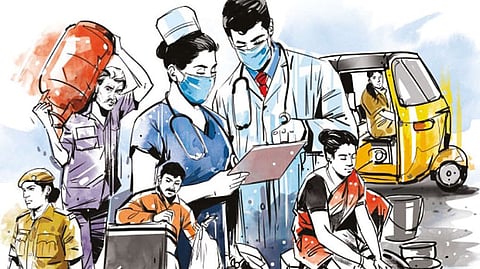

CHENNAI: As Tamil Nadu celebrates rapid urbanisation, this is also causing a surge in the cases of flu, viral infections and Influenza. The biotic pressure is adding to the multiple viral infections, experts pointed out.
Experts from the Directorate of Public Health and Preventive Medicine say that the cases of viral infections are more prevalent in urban settings because of pollution and overcrowding.
While H3N2 Influenza cases continue to rise in the State, the cases of H1N1 are also seeing a surge. Tamil Nadu recorded 545 cases of H1N1 Influenza until February, which is the highest number of cases of the virus in the country.
Maharashtra records the second highest with 170 cases. The State saw the highest number of 260 cases and one death due to H1N1 virus in January. A total of 955 cases have been reported in the country in 2023 so far.
But not all infections are due to H3N2. “Of the 24 kids admitted for fever, one-third were found to be infected with H3N2. It was based on random testing,” said a senior official from the Directorate of Public Health and Preventive Medicine (DPH). “As per the public health regulations, our focus is on providing symptomatic and supportive treatment to those infected and not to mandatorily test everyone.”
Dr Mohan Kumar, consultant paediatrician at Stanley Medical College and Hospital said that the rise in seasonal influenza was common. “There’s a spurt in the cases of acute respiratory infection from January to March. We’re expecting a decline in the cases after March. The surge in cases can also be witnessed after the monsoon months,” he added.
Experts say that people in urban settings depend on over-the-counter medications and do not practice self-isolation.
“The lack of isolation has led to a wider spread of the infection. In rural areas, people tend to stay in home isolation. This limits the number of people to exposure. However, in urban settings, it’s often crowded in public places and folks don’t isolate if they’re affected,” said Dr P Sampath, joint director, DPH.
Doctors opined that the infection was not directly related to pollution but it impacts overall health of the individual. “The risk of respiratory illnesses is high and also common due to Influenza,” said Dr V Vinod, consultant pulmonologist at Stanley Hospital. “Pollutants cause exacerbations of symptoms or underlying minor issues, making people more vulnerable to respiratory infections. The local immunity decreases because of these pollutants. Isolation and hydration are key for recovery and controlling the spread. Most cases include the upper respiratory tract infection and it’d gradually decline.”
Visit news.dtnext.in to explore our interactive epaper!
Download the DT Next app for more exciting features!
Click here for iOS
Click here for Android